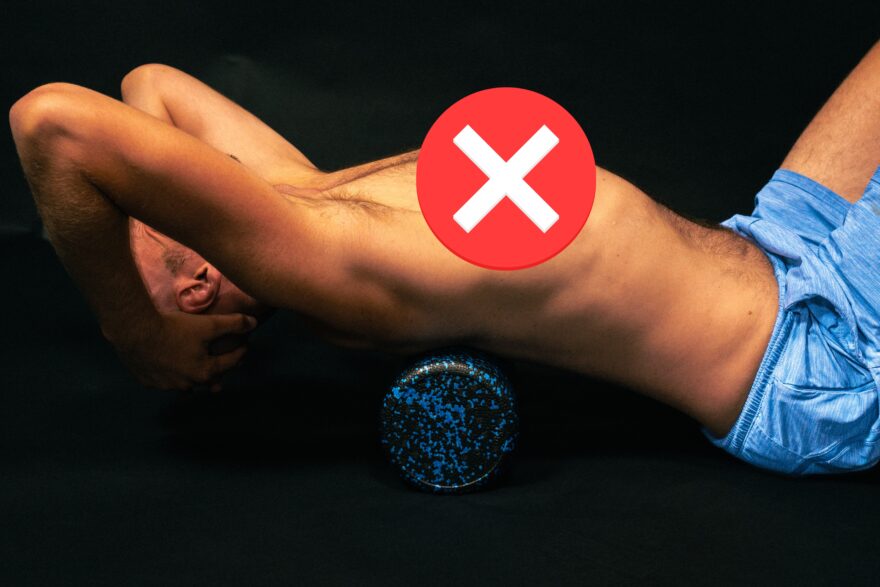Table of Contents
The Thoracic Mobility Myth: It’s Not Just About the Spine
If you struggle with being stiff and limited in your:
- Upper back
- Shoulder
- Neck
I bet someone told you that you have to improve your thoracic or T-spine mobility.
But I got news for ya!
You got duped. 😲
Why? Because almost ALL these drills are missing a key ingredient. Something that MASSIVELY impacts your results.
But don’t throw them in the trash yet. I’ll show you how you can up the efficacy. 🙌
Read the blog, watch the vid, and listen to the podcast below to learn!
The Four-Step Plan to Maximize Your Mobility 🗺️
There are four things you need to do to improve your mobility:
- Improve front-to-back ribcage dimensions
- Expand posterior thorax
- Expand anterior thorax
- Progressive rotation under load
Let’s dive into each:
1. Improve front-to-back ribcage dimensions
Did you know your rib cage changes shape? According to this study, the sidelying position increased the front-to-back ribcage shape.
So what?
The more cylindrical an object is, the easier it rotates. People who have upper body restrictions often have a less cylindrical ribcage shape. This happens with increased muscle activity and is quite common.
When you lie on your side, you’ll get bigger front-to-back, and a foam roller can enhance that even further.
We can use this and a foam roller for MAJOR results:
- Position the foam roller on the middle third of your rib cage.
- Bottom leg is near-parallel to the foam roller
- Top foot in front of the ankle
- Torso close to parallel to the ground
- Silent nasal inhale
- Exhale and melt into the foam roller
- Top arm reaching to ceiling with eyes on your arm
- Perform 3-5 sets x 5 breaths, 2 times per day for 2-4 weeks
2. Posterior expansion
When the backside expands, it fills the concave shape of the shoulder blade. This makes it easier for the shoulder blade to slide and glide when you move your arm overhead.
For this, I like a high depth rack squat or sandbag squat. The arm and leg angles help drive upper back expansion.
Here’s how:
- Grab two kettlebells or a sandbag. Don’t make them super heavy.
- Rest them so your arm is about 60º shoulder flexion.
- Look straight ahead with your feet flat on a ramp.
- Take a silent inhale through your nose, then exhale, knees forward, butt down.
- Stay heavy on the heels, but make sure the front of the foot stays flat.
- Hold and breathe quietly in through the nose, soft exhale through the mouth.
- Perform 3-5 sets x 5 breaths, 2 times per day for 2-4 weeks if holding position.
3. Anterior expansion
Expanding the front of the chest is necessary for shoulder internal rotation.
An easy way to drive this is by hanging from a bar.
- Grab a bar with a palm forward/pronated grip
- Dead hang
- Hold position and take a silent inhale through your nose, then a soft exhale through the mouth.
- Make sure your eyes continue to look forward.
- Perform 3-5 sets x 5 breaths, 2 times per day for 2-4 weeks
4. Drive rotation
When your thorax rotates, you expand in two ways:
- Posterior expansion on the side you’re rotating towards
- Anterior expansion on the opposite side
Cable presses at various angles are an easy way to drive this.
Here’s how:
- Eyes forward
- Exhale as you reach, inhale at the end position.
- Perform 2-3 sets x 8-12 reps two to three sets, eight to 12 reps a few times per week
If you REALLY want to up the ante, then you need to be able to rotate well under load.
The problem though, is that the heavier the load, the less you can rotate. Muscle activity needed to move heavy weights limits motion.
But there’s a workaround.
You just gotta use your head. Literally.
When you turn your head, you actually drive rotation all the way down to the fifth thoracic vertebrae or T5. This allows you to double dip–get stronger AND improve mobility.
- Start looking towards the direction you’re pressing to get some upper back expansion.
- Take a breath of air in through the nose.
- Then on the exhale, as you press up and overhead, turn your head the opposite way.
- Start with 2-3 sets x 8-12 reps. From there, you can add weight and reduce the number of reps.
Sum up
We now went ether on t-spine mobility drills. Move the ribs to truly unlock your shoulder, neck, and upper body rotation mobility. Master these moves and load them, and you’ll be well on your way to unleashing your movement.
To recap, here are the key takeaways:
- The ribcage must expand and contract to allow rotation to occur
- Keys are to increase front-to-back ribcage dimensions, expand those areas, then rotate.
- Head turns can add rotation to the thorax.
Happy rotating!
